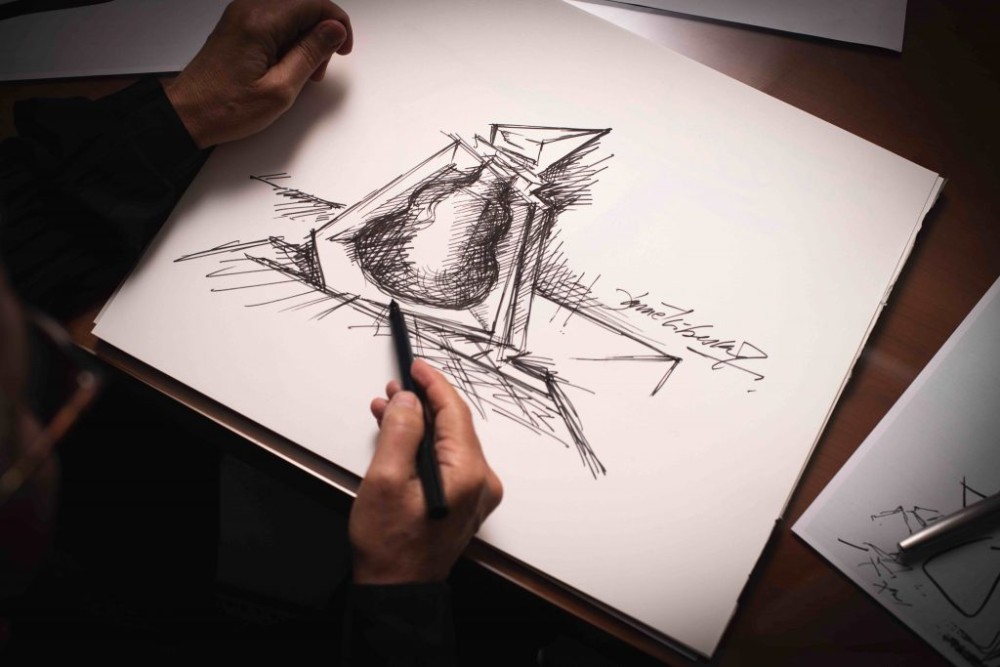Somewhat of a late bloomer having not completed his first building until the age of 52, Daniel Libeskind has now established himself and his influence as an architect with evocative designs synonymous with deconstructivism. He talks to Stephenie Gee about his collaboration with Hennessy and memory as a constant in his works

For Daniel Libeskind, architecture isn’t about buildings or aesthetics. Rather, it’s about commemorating heritage and evoking memories – something he sees as the fundamental component that shapes who we are by linking the past, present and future. “Without memory, we have no idea where we have gone or where we are going,” says the 76-year-old Polish-American architect. “It connects us to everything, including the future!”
The son of Polish Jews and Holocaust survivors, Libeskind uses this principle to guide his trademark style of slanted surfaces, jarring intersections and sharp angles that aim to trigger an emotional response. Listening, he says, is the most critical skill. “And not just the voices of the client and other stakeholders. I listen to the voices that come from a place – a site, a city, a neighbourhood. I try to observe and absorb the culture of a place and then communicate that through the design.”
Also see: From Central to Tsim Sha Tsui, 5 oyster places to try
From there, his ideas expand “into a flame of possibilities” before making their way onto paper then into the digital realm. “I always begin by creating hand sketches to work out my first ideas – sometimes hundreds are made,” he says. “Once I have a strong idea and sketch, I work with my design team to develop the form further on the computer. We then create 3D models that we can further develop.”

While his designs were criticised and at first dismissed for being unduly assertive and unconventional, these same qualities eventually led Libeskind to secure numerous prestigious, large-scale commissions. These include the Jewish Museum Berlin – his second completed building following the Felix Nussbaum Haus in Germany, which also marked the beginning of his illustrious career – One World Trade Center in New York, the Contemporary Jewish Museum in San Francisco and the Denver Art Museum. His latest venture, however, sees his world-class designs on a smaller scale – a redesigned bottle for French cognac distiller Hennessy as an “exceptional living tribute to its founder Richard Hennessy”.

As a longtime fan of cognac and its ability to ignite creative conversation – Libeskind and his wife make it a tradition to end every evening with a glass of Hennessy and reflect on the day – it was an absolute no-brainer to take part in such a collaboration. “I was immediately inspired at the prospect of creating a new decanter for the brand,” he says. “I have admired Hennessy for many years – it is the epitome of heritage luxury – so I was honoured to take on the challenge.
Also see: 100 Takes: Artist, photographer Phoebe Richardson records hottest days
“Cognac and architecture are not as different as you may think. There is a complexity, process and structure to cognac just as there is in architecture. My creative process is deeply informed by music, literature, poetry and philosophy, and I relish bringing a myriad of ideas from different backgrounds to the design of kin objects. I believe it elevates and brings new meaning to the design.”

Like his larger projects, this new Baccarat crystal decanter for the house’s rarest cognac – an exceptional, limited-quantity blend crafted from some of the scarcest caux-de-vie in Hennessy’s reserves, carefully selected and preserved in The Founder’s Cellar on the family estate – captures memories drawn from the maison’s rich 250 years of history and embodies its dedication to its craft, all whilst pushing the boundaries of a design object both in materials and form.
“The inspiration for the decanter came from the powerful emblem of Richard Hennessy as a symbol of the future of the brand,” says Libeskind, who found magic in this interplay between history and future. “I wanted to honour the history while elevating it!”

The roots of the Hennessy saga trace back to 1765, when Irishman Richard Hennessy – a military officer in service of King Louis XV of France – resolved to forge his own path, becoming not only a merchant but also a maker of outstanding and uncompromised cognacs. So deeply inspired by this story and legend of the founder, the image, Libeskind tells me, was “stuck in my mind’s eye when designing the bottle”.
Also see: Mandarin Oriental, Bodrum unveils new limited-time dining experiences
Rendered in an angular and tilted architectural form juxtaposed with a curved interior, the decanter design was approached in much the same way Hennessy creates its cognacs – slowly and deliberately – and began, like any project should, with research.

“I started by delving into the world of Richard Hennessy – to taste the various cognacs, visit the cellars and submerge myself in the rich tradition of the brand,” Libeskind says. “And to have the space and the time to reflect on the ritual of drinking cognac was such a unique experience. The process was much more intimate and personal, which is similar to the way in which you experience cognac.”
As for his advice for aspiring architects, it couldn’t be more fitting considering his own late start and encounter with criticism elicited by critics urging for a shift in aesthetics. “I always advise young architects to never have a goal – just find a path and follow it!”
Also see: A journey to a taste sensation with Christopher Ho





